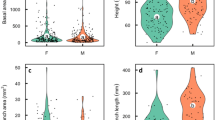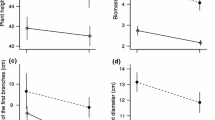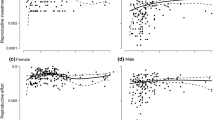Summary
We derived an index of reproductive effort (g reproductive tissue per g leaf) from data collected over two seasons on 28 males and 28 females of the dioecious shrub Oemleria cerasiformis. Males produced an average of three times as much flower and flower-stalk tissue as females, but because of their large fruits, females produced four times as much total reproductive biomass. Reproductive effort of both sexes was related to light. Fruit set in females (% carpels producing drupes) averaged 11.2% and was related to spring light levels. Male-biased sex ratios in this species may be related to the greater reproductive effort of females.
Similar content being viewed by others
References
Allen GA (1986) Flowering pattern and fruit production in the dioecious shrub Oemleria cerasiformis (Rosaceae). Can J Bot 64:1216–1220
Bawa KS, Keegan CR, Voss RH (1982) Sexual dimorphism in Aralia nudicaulis L. (Araliaceae). Evolution 36:371–378
Bazzaz FA, Carlson RW, Harper JL (1979) Contribution to reproductive effort by photosynthesis of flowers and fruits. Nature 279:554–555
Bullock SH (1982) Population structure and reproduction in the Neotropical dioecious tree Compsoneura sprucei. Oecologia (Berlin) 55:238–242
Bullock SH (1984) Biomass and nutrient allocation in a Neotropical dioecious palm. Oecologia (Berlin) 63:426–428
Charnov EL (1982) The theory of sex allocation. Princeton University Press, Princeton
Conn JS, Blum U (1981) Differentiation between the sexes of Rumex hastatulus in net energy allocation, flowering and height. Bull Torrey Bot Club 108:446–455
Cruden RW, Lyon DL (1985) Patterns of biomass allocation to male and female functions in plants with different mating systems. Oecologia (Berlin) 66:299–306
Freeman DC, Klikoff LG, Harper KT (1976) Differential resource utilization by the sexes of dioecious plants. Science 193:597–599
Friend DTC (1961) A simple method of measuring integrated light values in the field. Ecology 42:577–580
Grant MC, Mitton JB (1979) Elevational gradients in adult sex ratios and sexual differentiation in vegetative growth rates of Populus tremuloides Michx. Evolution 33:914–918
Gross KL, Soule JD (1981) Differences in biomass allocation to reproductive and vegetative structures of male and female plants of a dioecious, perennial herb, Silene alba (Miller) Krause. Amer J Bot 68:801–807
Hoffmann AJ, Alliende MC (1984) Interactions in the patterns of vegetative growth and reproduction in woody dioecious plants. Oecologia (Berlin) 61:109–114
Lloyd DG (1973) Sex ratios in sexually dimorphic Umbelliferae. Heredity 31:239–249
Lloyd DG (1984) Gender allocations in outcrossing cosexual plants. In: Dirzo R, Sarukhan J (eds), Perspectives on plant population ecology. Sinauer Associates, Sunderland, Massachusetts, pp 277–300
Lloyd DG, Webb CJ (1977) Secondary sex characters in plants. Bot Rev 43:177–216
Meagher TR, Antonovics J (1982a) The population biology of Chamaelirium luteum, a dioecious member of the lily family: life history studies. Ecology 63:1690–1700
Meagher TR, Antonovics J (1982b) Life history variation in dioecious plant populations: a case study of Chamaelirium luteum. In: Dingle H, Hegmann J (eds), Evolution and genetics of life histories. Springer, Berlin Heidelberg New York, pp 139–154
Neter J, Wasserman W (1974) Applied linear statistical models. Richard D. Irwin, Inc., Homewood, Illinois
Opler PA, Bawa KS (1978) Sex ratios in tropical forest trees. Evolution 32:812–821
Putwain PD, Harper JL (1972) Studies in the dynamics of plant populations. V. Mechanisms governing the sex ratio in Rumex acetosa and R. acetosella. J Ecol 60:113–129
Scholander PF, Hammel HT, Bradstreet ED, Hemmingsen EA (1965) Sap pressure in vascular plants. Science 148:339–346
Sokal RR, Rohlf FJ (1981) Biometry. W.H. Freeman and Company, San Francisco
sutherland S (1986a) Floral sex ratios, fruit-set, and resource allocation in plants. Ecology 67:991–1001
Sutherland S (1986b) Patterns of fruit-set: what controls fruitflower ratios in plants? Evolution 40:117–128
Vitale JJ, Freeman DC (1986) Partial niche separation in Spinacia oleracea L.: an examination of reproductive allocation. Evolution 40:426–430
Wallace CS, Rundel PW (1979) Sexual dimorphism and resource allocation in male and female shrubs of Simmondsia chinensis. Oecologia (Berlin) 44:34–39
Willson MF (1983) Plant reproductive ecology. Wiley-Interscience, New York
Willson MF (1986) On the costs of reproduction in plants: Acer negundo. Amer Midl Natur 115:204–207
Willson MF, Burley N (1983) Mate choice in plants: tactics, mechanisms, and consequences. Princeton University Press, Princeton
Williams K, Koch GW, Mooney HA (1985) The carbon balance of flowers of Diplacus aurantiacus (Scrophulariaceae). Oecologia (Berlin) 66:530–535
Author information
Authors and Affiliations
Rights and permissions
About this article
Cite this article
Allen, G.A., Antos, J.A. Relative reproductive effort in males and females of the dioecious shrub Oemleria cerasiformis . Oecologia 76, 111–118 (1988). https://doi.org/10.1007/BF00379608
Received:
Issue Date:
DOI: https://doi.org/10.1007/BF00379608




